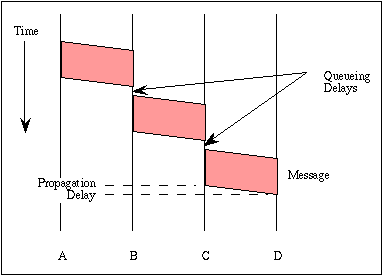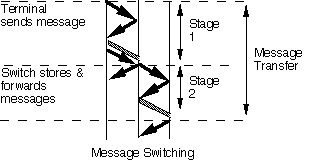
Sometimes there is no need for a circuit to be established all the way from the source to the destination. Consider a connection between the users (A and D) in the figure below (i.e. A and D) is represented by a series of links (AB, BC, and CD).

A connection between two systems A & D formed from 3 links
For instance, when a telex (or email) message is sent from A to D, it first passes over a local connection (AB). It is then passed at some later time to C (via link BC), and from there to the destination (via link CD). At each message switch, the received message is stored, and a connection is subsequently made to deliver the message to the neighboring message switch. Message switching is also known as store-and-forward switching since the messages are stored at intermediate nodes en route to their destinations.

The use of message switching to communicate between A and D
The figure illustrates message switching; transmission of only one message is illustrated for simplicity. As the figure indicates, a complete message is sent from node A to node B when the link interconnecting them becomes available. Since the message may be competing with other messages for access to facilities, a queuing delay may be incurred while waiting for the link to become available. The message is stored at B until the next link becomes available, with another queuing delay before it can be forwarded. It repeats this process until it reaches its destination.
Circuit setup delays are replaced by queuing delays. Considerable extra delay may result from storage at individual nodes. A delay for putting the message on the communications link (message length in bits divided by link speed in bps) is also incurred at each node en route. Message lengths are slightly longer than they are in circuit switching, after establishment of the circuit, since header information must be included with each message; the header includes information identifying the destination as well as other types of information.
Most message switched networks do not use dedicated point-to-point links and therefore a call must be set-up using a circuit switched network. The figure below illustrates the use of message switching over a circuit switched network, in this case using one intermediate message switch.

Message switching using circuit switched connections between message switches.
Although message switching is still used for electronic mail and telex transmission, it has largely been replaced by packet switching (in fact, most electronic mail is carried using message switching with the links between message switches provided by packet or circuit-switched networks).